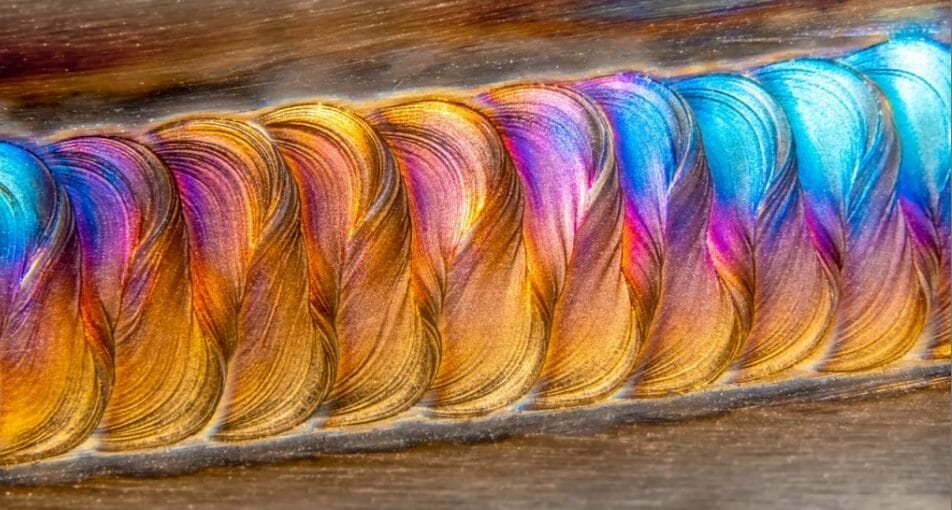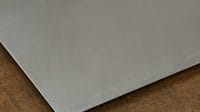Welcome to our comprehensive guide on everything you need to know about stainless steel weld color charts. For both professionals and beginners in the welding field, achieving accurate and consistent welds can be a challenging task. That’s where stainless steel weld color charts come into play. These charts serve as an essential tool for identifying the temperature range of a stainless steel weld and can help you detect any potential issues with the welding process. In this guide, we’ll explore the importance of stainless steel weld color charts, understanding weld colors and how to read a color chart, tips for using them effectively, and much more. Additionally, we’ll delve into the benefits of using colored stainless steel sheets in various applications along with maintenance tips. Let’s dive into the world of stainless steel weld color charts and learn how to achieve perfect welds every time!
Understanding Stainless Steel Weld Colors
Stainless steel weld colors are caused by a thin oxide layer that forms on the surface of the metal during the welding process. The color of the oxide layer varies depending on the temperature, duration of exposure to oxygen, and the chemical composition of the steel. This oxide layer can range from faint yellow to dark blue, with shades of purple and black in between. The color of the weld can provide valuable insight into the quality of the welding process and determine the susceptibility of the metal to corrosion and cracking.
The most common colors observed in stainless steel welds include straw, bronze, blue, and purple. Straw is the lightest color and occurs at a temperature range of 430-550°C. This color indicates that the weld has not been overheated, and the steel retains its strength and corrosion resistance. Bronze occurs at 550-630°C and signifies that the weld has reached the optimum temperature for joining the steel. Blue and purple colors indicate that the weld has been overheated, leading to reduced strength and corrosion resistance in the metal.
It’s important to note that each stainless steel grade has its own unique welding characteristics and may produce different weld colors. As such, it’s crucial to have a comprehensive stainless steel weld color chart on hand to accurately identify the colors and interpret their corresponding indications.
Importance of Stainless Steel Weld Color Chart
Stainless steel weld color charts are essential tools for any professional or beginner welder. These charts can help identify issues and ensure consistent and high-quality welds. By understanding the significance of each color, the welder can identify any potential overheating or underheating problems that may cause damage to the stainless steel sheets.

It is important to note that each color corresponds to a specific temperature range, which can vary depending on the type of stainless steel being welded. Therefore, having a comprehensive and accurate color chart is crucial for achieving optimal results.
Importance of Stainless Steel Weld Color Chart
Using a stainless steel weld color chart can serve as a valuable reference tool for achieving consistent welds. It is particularly useful in applications where the visual appearance of the welded stainless steel is crucial, such as architectural projects or decorative items.
Furthermore, a color chart can help prevent costly mistakes by identifying the cause of any discoloration or inconsistencies in the weld, allowing for immediate rectification of the issue.
How to Read a Stainless Steel Weld Color Chart

Reading a stainless steel weld color chart may seem daunting at first, but with some practice and guidance, it can become a useful tool for achieving consistent and high-quality welds. Here is a step-by-step guide on how to read and interpret a stainless steel weld color chart:
Step 1: Identify the Colors and their Corresponding Temperature Ranges
Most stainless steel weld color charts use a gradient of colors to indicate a range of temperatures. The colors observed during the welding process correspond to these temperature ranges. The chart will typically provide a key indicating the colors and their corresponding temperature ranges. For example, a common color chart may include the following colors and temperature ranges:
| Color | Temperature Range |
|---|---|
| Black | Below 800°F |
| Dark blue | 800°F – 1,000°F |
| Light blue | 1,000°F – 1,200°F |
| Golden yellow | 1,200°F – 1,400°F |
In the above example, black indicates a temperature below 800°F, while golden yellow suggests a range of 1,200°F to 1,400°F.
Step 2: Locate the Weld Color on the Chart
Once the color of the weld is observed, determine its corresponding temperature range by locating it on the chart. It is recommended to compare the actual color to the chart under similar lighting conditions and viewing angles to ensure maximum accuracy.
Step 3: Identify any Indications or Symbols
Some stainless steel weld color charts may include additional indications or symbols to provide further guidance. For instance, the chart may indicate the type of shielding gas or the specific grade of stainless steel that the color chart is compatible with. Make sure to pay attention to any symbols or indications included, as they can be crucial in achieving the desired weld quality.
By following these simple steps, you can effectively use a stainless steel weld color chart to achieve accurate and consistent welds.
Tips for Using a Stainless Steel Weld Color Chart
Using a stainless steel weld color chart can be immensely helpful in achieving accurate and consistent welds. Here are some valuable tips for using a color chart effectively:
- Ensure proper lighting: Adequate lighting is essential for accurately determining the weld color. Avoid using colored filters or lenses that could affect color perception.
- Positioning and angle: The color chart should be positioned perpendicular to the line of sight, with the weld area in the foreground. Try to avoid reflection or glare that could distort the color perception.
- Understand color gradients: Familiarize yourself with the different color gradients on the chart and the corresponding temperature ranges to accurately identify the weld color.
- Update the color chart: Regularly update the color chart to keep it current and accurate. This is especially important when using different grades of stainless steel or when welding under varying conditions.
- Use in combination with other tools: While a color chart is a useful tool, it should be used in combination with other tools such as thermometers or pyrometers for obtaining accurate temperature readings.
Remember, the key to using a stainless steel weld color chart effectively is practice and experience. Continual learning and experimentation will help you master the art of welding with precision and confidence.
Benefits of Using Colored Stainless Steel Sheets
Colored stainless steel sheets offer a range of benefits that make them a popular choice for various applications. Whether it’s architectural projects, signage, or decorative items, colored stainless steel sheets can enhance the visual appeal of any project.
One of the biggest advantages of using colored stainless steel sheets is their durability. Stainless steel is known for its excellent corrosion resistance properties, which makes it an ideal material for colored applications. This means that colored stainless steel sheets can maintain their vibrant colors and overall appearance for years to come.

Another benefit of using colored stainless steel sheets is their versatility. With a wide range of colors and finishes available, designers and architects can easily find a color that matches their vision. Popular colors such as gold, black, rose gold, and bronze can be achieved with a variety of surface finishes like brushed, mirrored, and satin.
Colored stainless steel sheets can also be customized to achieve specific colors and finishes. This opens up a world of possibilities for creating unique and personalized designs that stand out from the crowd.
In conclusion, colored stainless steel sheets offer a unique blend of durability, versatility, and customization options that make them an excellent choice for various applications. Their vibrant colors and overall appearance will enhance the visual appeal of any project, while their corrosion resistance properties will ensure they stay looking great for years to come.
Available Colors and Finishes for Stainless Steel Sheets
When it comes to colored stainless steel sheets, there are various options available to choose from. From bold and vibrant hues to subdued and elegant finishes, stainless steel sheets can be customized to complement any design vision or project requirement.

Some of the most popular colors for stainless steel sheets include gold, black, rose gold, and bronze. Each of these colors can be achieved via specialized coating processes, creating a durable and long-lasting finish. In addition, different surface finishes such as brushed, mirrored, and satin are also available to add texture and depth to the stainless steel sheets.
Customization options are also abundant, allowing manufacturers to produce unique colors and finishes to fulfill specific project requirements. The possibilities are endless when it comes to colored stainless steel sheets, making them a versatile and attractive option for various applications.
Maintaining Colored Stainless Steel Sheets
Colored stainless steel sheets are a popular choice for architectural and decorative applications due to their vibrant hues and durability. However, proper maintenance is crucial to preserve their appearance and longevity. Here are some tips for maintaining colored stainless steel sheets:
- Avoid using abrasive materials or harsh cleaning agents that can scratch or damage the colored surface. Instead, use a soft cloth and mild detergent to clean the sheets.
- Regularly inspect the surface for any signs of damage or discoloration. Promptly address any issues to prevent further damage.
- Avoid exposing colored stainless steel sheets to corrosive materials or harsh environments as much as possible.
- Apply a protective coating or film to the colored surface to prevent scratches and fading over time.
Proper maintenance of colored stainless steel sheets can enhance their appearance and extend their lifespan, making them a valuable investment for any project.
Common Mistakes to Avoid When Welding Stainless Steel
Welding stainless steel involves a unique set of challenges and requires a certain level of skill and experience to achieve high-quality welds consistently. Even experienced welders can make mistakes that can compromise the weld quality or, in worst cases, result in dangerous situations. Here are some common mistakes that welders should avoid:
1. Overheating the Metal
Stainless steel is highly sensitive to heat, and overheating can cause the metal to warp, distort, or even crack. Additionally, overheating can result in discoloration, making it difficult to achieve a consistent weld. To avoid overheating, welders should monitor the temperature closely and use intermittent welding techniques to allow the metal to cool.
2. Using the Wrong Shielding Gas
The use of the correct shielding gas is crucial for achieving a successful weld. Welders should ensure that they are using the right mix of gases for the specific type of stainless steel they are working on. Using the wrong shielding gas can result in insufficient protection against the atmosphere, leading to oxidation and the formation of discoloration.
3. Contamination
Contamination is a major issue in stainless steel welding and can result in poor weld quality. Contamination can come from various sources, including dirt, oil, and grease. Welders should make sure to clean the metal thoroughly before welding and avoid using contaminated equipment.
4. Poor Technique
Good welding technique is essential for achieving a high-quality weld. Welders should ensure that they are using the right welding technique for the specific type of stainless steel they are working on. Additionally, they should maintain the correct welding speed, angle, and amperage for the best results.
5. Lack of Protection for the Welding Zone
Welding produces intense heat, bright light, and harmful gases that can be dangerous to the welder and anyone nearby. Welders should take measures to protect the welding zone, including wearing protective clothing, using proper ventilation, and placing a barrier around the welding area.
By avoiding these common mistakes, welders can achieve high-quality welds consistently, ensuring that the end product is durable, safe, and visually appealing.
Read More : Choose the Right Gas for TIG Welding Stainless Steel
Does Coloring Stainless Steel Affect its Welding Integrity?
Coloring stainless steel process, such as using electrochemical methods or powder coating, can alter the appearance of the material. However, it is important to consider if this affects the welding integrity. While coloring may not directly impact weld quality, it can potentially change the material’s surface properties, requiring modifications in the welding process to ensure optimal results.
What Are the Different Weld Colors in Stainless Steel?
The stainless steel wire mesh chart provides a useful reference for understanding the different weld colors found in stainless steel. These colors include straw, blue, gold, and purple, which indicate different temperatures reached during the welding process. The chart aids in identifying potential issues, ensuring proper heat treatment, and maintaining the integrity of stainless steel welds.
Frequently Asked Questions about Stainless Steel Weld Color Chart
If you’re just starting out with welding or you’re looking to improve your welding skills, understanding stainless steel weld color charts is crucial. Here are some of the most frequently asked questions about stainless steel weld color charts:
How do I create a personalized stainless steel weld color chart?
Creating a personalized stainless steel weld color chart requires a bit of effort, but it’s worth it. You can do this by welding small test pieces of stainless steel in the same manner as your work piece. Then, you can mark the colors that are produced on the metal and note their corresponding temperatures. This chart will serve as a reference guide to help you create consistent and accurate welds.
Can I use the same stainless steel weld color chart for different grades of stainless steel?
It is recommended that you use a separate color chart for each grade of stainless steel that you work with. Different grades of stainless steel will have different chemical compositions and will therefore produce different colors during the welding process. Using the wrong color chart can lead to inaccurate temperature measurements and poor weld quality.
How do different welding techniques affect the color formation?
Different welding techniques can affect the color formation in stainless steel welds. For example, welding with a higher heat input will produce brighter colors compared to lower heat inputs. Similarly, using a lower shielding gas flow rate may lead to a more oxidized weld, resulting in different colors. It’s important to take note of the color changes and adjust your welding techniques accordingly.
How can I ensure the accuracy of my stainless steel weld color chart?
To ensure the accuracy of your stainless steel weld color chart, it is important to use a consistent welding technique and take note of the temperature readings for each color. It’s also recommended that you update your color chart periodically to account for any changes in your welding process or equipment. Additionally, you should always use proper lighting and viewing angles when checking the color of your welds.
Can I rely solely on the stainless steel weld color chart for weld quality control?
While the stainless steel weld color chart is a valuable tool for maintaining weld quality, it should not be the only method of quality control. It’s important to also visually inspect your welds and use other testing methods such as x-rays or ultrasonic testing to ensure that the weld meets the required specifications and standards.
By understanding and utilizing a stainless steel weld color chart, you can improve the accuracy and consistency of your welds. Keep these frequently asked questions in mind to help you make the most of this valuable tool.






